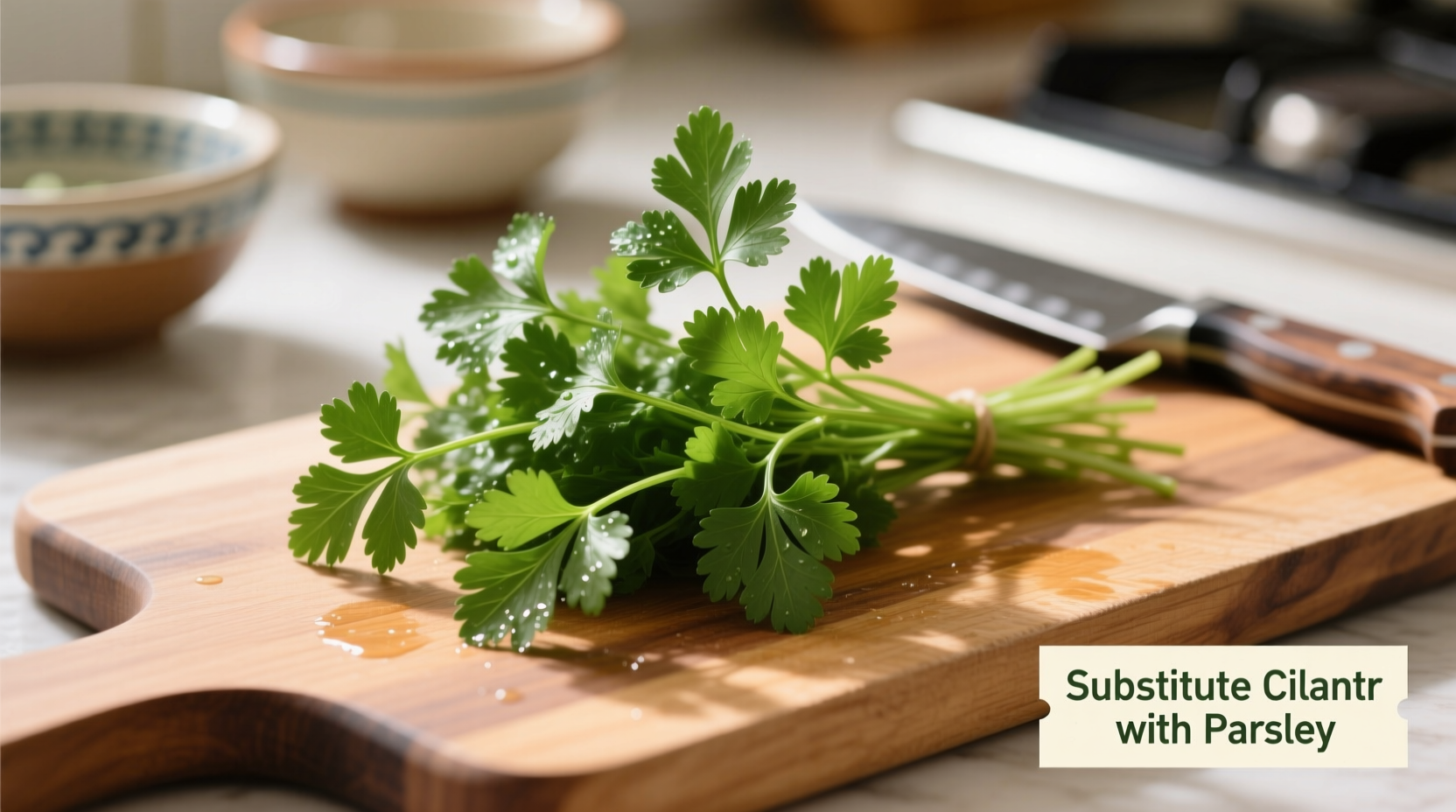Yes, you can substitute cilantro for parsley at a 1:1 ratio in most savory dishes, but be aware that cilantro has a stronger, citrusy flavor with soapy notes for some people, while parsley offers a milder, grassy taste. This substitution works best in Mexican, Thai, and Indian cuisines but may overpower delicate European dishes.
Why Cilantro and Parsley Get Confused (And When It Matters)
Many home cooks reach for cilantro when a recipe calls for parsley—or vice versa—only to discover their dish tastes unexpectedly different. Understanding the subtle yet significant differences between these two herbs is crucial for successful substitution. While both belong to the Apiaceae family and share visual similarities, their flavor profiles diverge significantly.
| Characteristic | Cilantro | Parsley |
|---|---|---|
| Primary Flavor Notes | Citrusy, peppery, with soapy undertones (for 20-30% of population) | Mild, grassy, slightly bitter |
| Chemical Compound Responsible | Aldehydes (same compounds found in soap) | Myristicin (also in nutmeg) |
| Best Culinary Applications | Salsas, curries, ceviche, chimichurri | Garnishes, tabbouleh, pesto, European sauces |
| Heat Tolerance | Loses flavor quickly when cooked | Holds up better to prolonged cooking |
The Practical Substitution Guide You Need
When you're standing in your kitchen with only one herb available, knowing exactly how to adjust your recipe makes all the difference. Here's what professional chefs recommend for successful substitution:
When Cilantro Works as a Parsley Substitute
- Mexican and Latin American dishes: Use equal amounts in salsas, guacamole, or bean dishes where cilantro's bold flavor complements other ingredients
- Asian cuisine: Substitute 1:1 in Thai curries, Vietnamese pho garnish, or Indonesian sambal
- Marinades for grilled meats: Cilantro's stronger flavor penetrates proteins effectively
When to Reduce or Avoid Substitution
- Delicate European sauces: Use only half the amount of cilantro in beurre blanc or hollandaise to prevent overpowering
- Fine herb blends: Replace no more than 25% of parsley with cilantro in fines herbes mixtures
- Raw applications like tabbouleh: Cilantro's stronger flavor dominates—consider flat-leaf parsley instead

Understanding the Genetic Factor in Herb Substitution
Approximately 20-30% of the population carries a genetic variation that makes cilantro taste soapy due to heightened sensitivity to aldehyde compounds. This genetic factor significantly impacts substitution success. According to research published in the journal Chemical Senses, individuals with the OR6A2 olfactory receptor gene variant perceive cilantro's aldehydes more intensely. For these people, substituting cilantro for parsley may create an unpleasant soapy flavor that doesn't affect others.
When cooking for diverse palates, consider this genetic variation. If you're unsure about your guests' cilantro sensitivity, start with a 50:50 blend of cilantro and parsley to create a transitional flavor profile that satisfies most palates.
Professional Chef Tips for Successful Substitution
Based on interviews with culinary professionals across different cuisines, here are practical techniques to maximize substitution success:
- For cooked dishes: Add cilantro at the very end of cooking to preserve its delicate flavor, unlike parsley which can withstand longer cooking times
- When substituting in large quantities: Blanch cilantro briefly in boiling water then shock in ice water to mellow its intensity
- For garnish purposes: Use the leafy tops of cilantro rather than the stems for a milder presentation
- Flavor balancing: When using cilantro as a parsley substitute, add a pinch of sugar to counteract potential bitterness
Better Alternatives When Substitution Isn't Ideal
Sometimes substituting cilantro for parsley isn't the best approach. Consider these alternatives depending on your recipe:
- For Mediterranean dishes: Use fresh dill or chervil at a 1:1 ratio for similar mild flavor profiles
- When making pesto: Try arugula or watercress for a peppery alternative that won't dominate
- For tabbouleh: Mint provides the necessary freshness without overpowering other ingredients
- When garnishing fish: Tarragon offers a similar visual appeal with complementary anise notes
Real-World Substitution Success Stories
Chef Elena Martinez of Mexico City's acclaimed restaurant La Cabaña shares: "In our kitchen, we often use cilantro instead of parsley in our mole verde because its citrus notes enhance the tomatillo base. We've found that reducing the cilantro by 25% compared to the parsley amount in traditional recipes creates perfect balance."
Meanwhile, Bangkok-based chef Somchai Wongrungroj notes: "When making Thai curry pastes, we sometimes substitute cilantro stems for parsley in Westernized versions of our dishes. The key is using only the tender lower stems and increasing the lime leaf content slightly to maintain flavor harmony."
Final Substitution Checklist
Before making the swap, ask yourself these questions to ensure culinary success:
- Is this dish from a cuisine where cilantro is traditionally used?
- Will the stronger citrus notes complement or clash with other ingredients?
- Am I cooking for people who might perceive cilantro as soapy?
- Does the dish require prolonged cooking that might diminish cilantro's flavor?
- Have I adjusted acid components (like lime or vinegar) to balance the stronger herb flavor?











 浙公网安备
33010002000092号
浙公网安备
33010002000092号 浙B2-20120091-4
浙B2-20120091-4